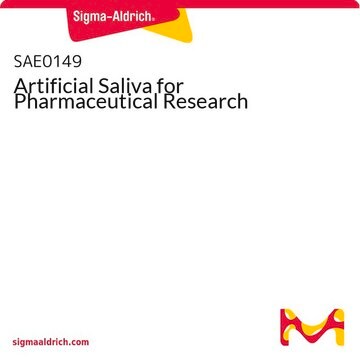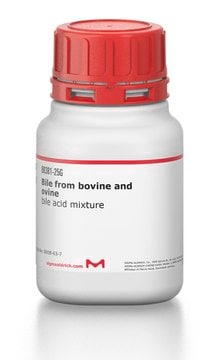Mucins are soluble in water, forming hazy viscous solutions.
M1778
Mucina
Type III, bound sialic acid 0.5-1.5 %, partially purified powder
Sinonimo/i:
MUC
Scegli un formato
Scegli un formato
About This Item
Prodotti consigliati
Origine biologica
Porcine stomach
Tipo
Type III
Stato
partially purified powder
Composizione
bound sialic acid, 0.5-1.5%
tecniche
microbiological culture: suitable
Solubilità
NaOH: soluble 20 mg/mL
Temperatura di conservazione
2-8°C
Cerchi prodotti simili? Visita Guida al confronto tra prodotti
Categorie correlate
Descrizione generale
Applicazioni
Azioni biochim/fisiol
Nota sulla preparazione
Codice della classe di stoccaggio
11 - Combustible Solids
Classe di pericolosità dell'acqua (WGK)
WGK 3
Punto d’infiammabilità (°F)
Not applicable
Punto d’infiammabilità (°C)
Not applicable
Dispositivi di protezione individuale
Eyeshields, Gloves, type N95 (US)
Scegli una delle versioni più recenti:
Certificati d'analisi (COA)
Non trovi la versione di tuo interesse?
Se hai bisogno di una versione specifica, puoi cercare il certificato tramite il numero di lotto.
Possiedi già questo prodotto?
I documenti relativi ai prodotti acquistati recentemente sono disponibili nell’Archivio dei documenti.
I clienti hanno visto anche
Articoli
Understand sialic acid structure, function, signaling, and modifications. Easily find products for sialic acid research.
-
Can I reconstitute the mucin so that it forms a saliva/snot-like substance? I can't seem to find any papers that have done this...
1 answer-
Helpful?
-
-
What does the "Type" designation in Mucin from porcine stomach mean?
1 answer-
The type designation does not have any particular biological significance. It is used to emphasize differences in the listings of this product.
Helpful?
-
-
What are the differences between Mucin from porcine stomach Products M2378 and M1778?
1 answer-
Product No. M2378 is a crude mucin preparation. Product No. M1778 is a partially purified powder prepared according to the method described in Glenister, D.A. and Salmon. K. Microbial Ecol. in Health & Disease 1, 31, (1988). The amount of bound sialic acids are also different. Please refer to the specification sheets on our website.
Helpful?
-
-
Is Product M1778, Mucin from porcine stomach, a purified preparation of mucin?
1 answer-
This product is a partially purified preparation of mucin based on the method of Glenister cited on the product's webpage.
Helpful?
-
-
What is the molecular weight of Product M1778, Mucin from porcine stomach?
1 answer-
This product is partially purified from crude mucin, M2378. Sigma has not determined the molecular weight of this product. Neither has the sugar and amino acid composition been determined.
Helpful?
-
-
How can I solubilize Product M1778, Mucin from porcine stomach?
1 answer-
Mucin is not readily soluble in aqueous solutions. Turbid "solutions" will form at about 5 mg/mL in 0.1 M acetate buffer, pH 5.0. To try to increase the solubility, one might try further dilution and sonication, but we have not tried this in our labs.
Helpful?
-
-
What is the Department of Transportation shipping information for this product?
1 answer-
Transportation information can be found in Section 14 of the product's (M)SDS.To access the shipping information for this material, use the link on the product detail page for the product.
Helpful?
-
Active Filters
Il team dei nostri ricercatori vanta grande esperienza in tutte le aree della ricerca quali Life Science, scienza dei materiali, sintesi chimica, cromatografia, discipline analitiche, ecc..
Contatta l'Assistenza Tecnica.












